Question and Answer – June 2008
E-gardens is a great way to help with your plant questions. However, it’s a visual medium, so questions that come with photos attached will always get top priority. We had almost 100 long questions this month. In order to be as fair as I could, I used only those that came with photos. I pledged 10 hours to open, edit and answer this part of e-gardens, and that was the best way of helping our readers. Even then, it took longer. However, I believe I’ve answered every question that came in with a photo. If you can’t send a photo, I’d love to hear from you on any of my radio programs.
One other tiny request that would be a big help to me selfishly: If you could only send images in the 50-400 kb file size, that would be terrific. One of the files arrived with more than 10 MB of photos, each of them 16 by 38 inches in size. Even with the fairly high-speed access where we live, it took upwards of half an hour just to download, open, crop and downsize those photos from that one e-mail. In advance, thanks!
Chatting aside, here are your questions.

Question: We planted these red oleanders 5 years ago. This spring’s very strong winds have left them with a permanent lean. What can we do? R.K., Plano.
Answer: Trim them to reshape them as soon as they finish blooming. Hopefully you’ll not have to remove more than 25 to 30 percent of the top growth. Follow the trim with an application of a quality all-nitrogen fertilizer to get the fastest possible regrowth and fill-in. They should look great by the end of this season.

Question: I believe I have a red oak with oak wilt. I’ve checked all the odd problems such as weedkillers and gas leaks. This started last year during all the rains. Is this tree salvageable? If not, I’d rather put my money toward a new tree. J.A., Fairview.
Answer: This is iron deficiency. Some of your close-up photos show the characteristic dark green veins with yellowed blades, most prominent on the newest growth at the ends of the branches. It looks like you don’t have a true Shumard red oak, and that alone will eventually lead to loss of the tree. You’ll see scores of other red oaks doing the same thing across the Metroplex. It’s also possible that the trunk suffered serious sunscald after the tree was planted. Again, that’s a common situation due to the tree’s lack of protective bark. Either way, it’s probably not oak wilt, and your money would probably be better spent on a new tree, perhaps a cedar elm or Chinese pistachio.
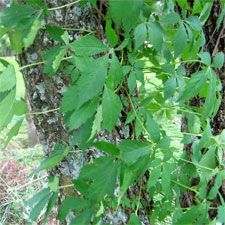
Question: I’ve been told this is Virginia creeper. It has climbed up several of my trees, and I’m wondering if it will end up hurting them? Wayne, no city given.
Answer: Indeed, this is Virginia creeper. It’s a close relative of Boston ivy, although more people actually confuse it with the unrelated poison ivy. Virginia creeper’s leaves have five leaflets, as your photo clearly shows. Poison ivy has three. Virginia creeper actually does not harm trees as it grows up their trunks and out on their branches. You just wouldn’t want to let it grow out and over the trees’ canopies. That would be too much shade. By the way, Virginia creeper has some of the richest red foliage of any native Texas plants each autumn.
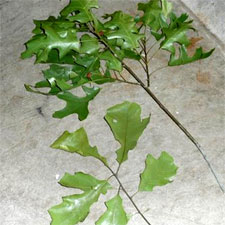
Question: This year a few of the leaves growing on my single-trunk oak are different from the others. This has not happened before. What might be going on? B.W., Bedford.
Answer: It would help a little to know where in the body of the tree these odd leaves have shown up. The top twig is Shumard red oak. Actually, the bottom leaves look like juvenile foliage that Shumard red oaks produce when they’re young and when new shoots develop either down low on the trees or within the heavy tree canopy. My bet would be that it is absolutely normal for your tree.

Question: What is wrong with my live oak tree? It has these bumps on several of its branches. I cut out as many as I could. Will they hurt the tree?
S.R., Killeen.
Answer: That’s one of the many oak galls. Each type is caused by a specific type of insect that stings the plant tissue and lays her eggs. Normally they only affect leaves or very small twigs. This type does do a little more damage since these are slightly larger twigs. Pruning is a good way to remove the current generation. This is not normally a serious problem for live oaks, so hopefully the next generation won’t be very prolific. There are no effective chemical sprays or systemics for oak galls.
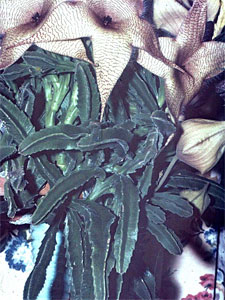
Question: You have said that you normally don’t do plant IDs here, but I’m hoping you’ll help us find a very special plant our grandmother grew. I found several photos of her and her plants. What is this one, and how hard is it to find? C.N.S., no city given.
Answer: I’d be honored to help with an ID in this case. This is Stapelia gigantea, more commonly known as starfish flower. There are many other types of stapelias and huernias, but this one has the largest (and foulest-smelling) flowers. While they look like cacti, they’re actually in the milkweed family. This one is fairly easy to find, although it won’t usually be bought in flower. Nurseries sometimes sell it, and Cactus and Succulent Society sales will almost always offer it. It’s quite available online. I’ve had this plant in my own collection for most of my life. Nice potted plant for a bright, frost-free setting. Good luck!
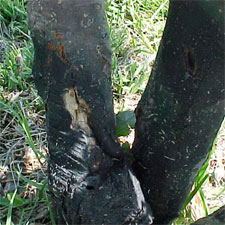
Question: The photo of my redbud tree shows the bark and some of the underlying tissue eroding away within the trunk. Could ants cause this? Is it sunscald, or some type of disease? I have two trees doing this, and a couple of young crabapple trees faced the same fate. The trees are in black clay gumbo. T.W., Leonard.
Answer: It does have the characteristic symptom (vertical cracking and dried tissues) of sunscald. However, you also need to look closely for signs of borers in the trunks (pencil-lead-sized holes in the trunk) and any kind of decay that might have occurred around a branch that might have been cut off. If the damage usually started low in the trees, it could even be from nicks administered by a lawn mower or trimmer. Even though they’re native trees, redbuds do have some issues that cause them to be comparatively short-lived (20-30 years). For the record, the ants are merely hiding out in the deteriorated tissue. Crabapples suffer mightily from both cotton root rot and cedar-apple rust. They are rarely successful for very many years in your part of Texas. Their problem may have been unrelated.
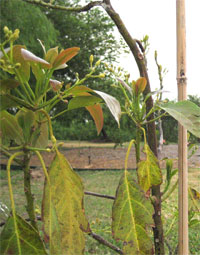
Question: I purchased this Haas avocado tree a year ago. It seemed to be doing fine until about a month ago, when I noticed black blotches on the trunk. It produced new growth, but that died back, too. What can I do to save it? M.B., Brownsville.
Answer: I am so sorry that I can’t nail this tree’s issue down precisely, but it looks like a similar problem to a couple of the other questions in this e-gardens. Blackening stem tissue usually indicates either sooty mold growing on a plant’s stems, or it can be sunscald or some other type of injury and decay. Other than looking like it needs some nitrogen, the new growth shown in your photo looks fairly vigorous.
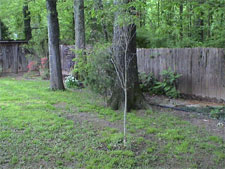
Question: I’d like some shade- loving groundcover suggestions for what I could plant in this part of our back yard between the fence and the rock pathway and between the azalea and the leatherleaf mahonia. A 1-foot sprinkler pops up next to the fence about 3 feet from the azalea. P. Conway, Arkansas.
Answer: What most of us wouldn’t give to have your kind of shade! The best shade groundcovers for your area would be ferns, ivy, mondograss, liriope and, in small areas, ajuga. It’s always nice to use a variety of two or three adjoining groundcovers if you’re dealing with a large enough area. You could use Encore or other azaleas, and I’m always tied closely to dwarf hollies of many, many sorts. I have a massed planting of leatherleaf mahonias, so you might even consider adding several more of those if you preferred. Carolina jessamine tumbling over the fence from the outside would be beautiful as well. Finally, although you didn’t really ask for any broader suggestions, this would be the perfect time to do an entire landscape remodel if you were so inclined. You have a lovely setting with grand potential, and you really shouldn’t feel that you have to leave all of the elements you mentioned in place. You could, easily enough, move an azalea or two and the leatherleaf mahonia, even the rock path. This might be a good year to do a backyard makeover. Your nurseryman could show you some great plants and ideas. Good luck with it!
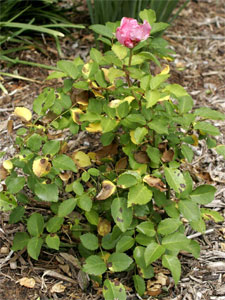
Question: I planted two Belinda’s Dream EarthKind® roses on opposite sides of my house (north and south). They’re in similar settings, but one of them has developed black spot. Was this disease inherent with the soil on that side of the house, or did it come with the plant? How can I treat it to help it recover? L.H., North Richland Hills.
Answer: Black spot is everywhere in our environment. You can plant a rose that has never been bothered by it, and, if conditions aren’t exactly perfect, black spot will develop. Even the fabulous EarthKind® roses are subject to it, but their difference is that it normally doesn’t do much harm to them. You mentioned the two plants are on opposite sides of your house, and that one is north. That tends to be a shadier side of most houses. Roses must have full sunlight and good air movement over their leaves. High humidity and warm, stagnant air result in serious problems with black spot. You may have to move the one plant to accommodate those requirements, but you shouldn’t have to spray Belinda’s Dream for black spot. If you want to grow roses, it’s one of your best choices.
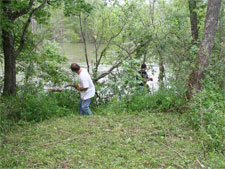
Question: My husband is allergic to poison ivy. As you can see, he’s busy clearing several acres we just bought in southern Oklahoma. What can we do to kill the vine? L.B., no city given.
Answer: First, if he has a high allergy, the best thing to do would be to hire someone who does not have that allergy to do a rough clearing of as much of the property as possible with a brush hog. That will shred all the small brush on the ground, poison ivy included. That’s usually a one-time job and it won’t be that expensive. Then, as for the poison ivy control, there is a complete answer within our Most Asked Questions. Click here to see it.
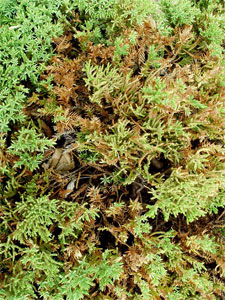
Question: The attached photo of my Green Mound juniper shows how it is dying. It started several months ago, and it seems to be spreading. I sprayed several weeks ago with an insecticide, but it didn’t seem to help. What can I do to save it? B., Garland.
Answer: This is spider mite damage. The mites that attack junipers start in February (months ahead of most other mites). They can kill entire plantings of groundcover and even shrubby junipers without gardeners ever knowing what has hit their plants. When they are active you’ll see fine webbing along the twigs. If you thump an affected (but still living) twig over a sheet of white paper you’ll be able to see the nearly microscopic mites (not true insects, but more closely related to chiggers and spiders) crawling around. Use a general-purpose insecticide labeled for mites. Check a few days after each application to see if you still have living, crawling mites.
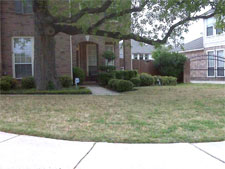
Question: I have a very old post oak in the front yard of my home. The house was built 8 years ago, and we hired professional care to nurse the tree along. It has done very well, but now I see black sap coming from one of the front knots on the main branch. I know that can’t be good. What should I do? P.D., no city given.
Answer: Construction is the worst enemy of post oaks, but it sounds like you did everything right. Congratulations! As for the black ooze, you’re right about its not being good. It indicates decay and moisture. Only an arborist on-site and up-close can determine if there is real cause for concern. Severed branches may just need time to heal and seal off the knots that are beneath them. If you see an active roll of new bark forming across the wound, that’s a good sign. However, if there is no new bark, the tissue within the remaining branch may be deteriorating and rotting back farther. An arborist will know what to do, but call in a good one. Look for credentials, years in the business and lots of references. Your local independent retail nurseryman may know a good one to recommend.
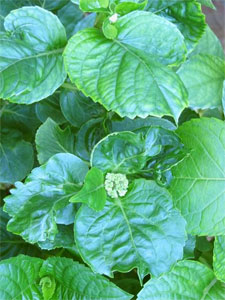
Question: My hydrangea’s leaves are wrinkled. I added super phosphate and a granular fertilizer. We’ve had a couple of good rains since, and I’ve watered in between. Is this wrinkling normal? C.W., S.W. Fort Worth.
Answer: Not much is "normal" with hydrangeas in alkaline soils like you have. They’re not too happy with the alkalinity, and iron deficiency can show up fairly quickly. The irrigation water from your hose will also be extremely alkaline. However, this looks like some very minor issue with temporary drying, wind, aphids, or some other cause of short-term challenge. Keep the plant moist at all times. It will always be your first landscape plant to wilt, so you can use it as your indicator plant for when it’s getting to be time to run the sprinklers. You may even have to hand-water it in between.
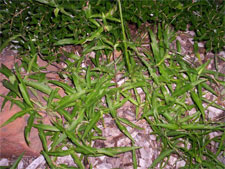
Question: I’m having trouble identifying an annoying weed – more than that, with controlling it. It’s a very fast grower, and it’s spreading. I’ve sprayed Image to eliminate nutsedge in the same bed, but I really haven’t noticed any change in either weed. I also applied a pre-emergent weedkiller early this spring, yet more weeds. Please help. D.W., Keller.
Answer: I am very familiar with this weed and frankly have never worried about its name. However, neither Image nor a pre-emergent weedkiller will do anything to control it. You will have to apply a broadleafed weedkiller (containing 2,4-d) to stop it. You may want to add one or two drops of liquid dishwashing detergent to help the spray stay in place on the leaves. You will have to be ultimately careful using any broadleafed weedkiller around desirable shrubs, groundcovers and flowers – so much so that you may want to paint it on with a foam rubber paintbrush. As to the nutsedge, you mentioned spraying Image on it without results. Many people misapply Image. While you do spray it on, you must immediately soak it into the soil. It must enter the soil, then the nutsedge roots before it can kill the plant tops. It’s very slow-acting, often taking 3 to 4 weeks before you’ll see any results. It requires two applications 30 days apart, and both must fall between May 15 and September 15. Any deviation from those instructions will usually lead to poor results. Finally, all of that said, I will tell you that I have gotten to a similar place in some of my old beds, and I’ve always found it much easier simply to remove the oil soil 10 to 12 inches down and rework the entire planting area. By the time weeds get completely involved in a bed, all of the original organic matter is usually gone anyway. That may not be appealing at this point, but it’s probably how I would handle it all – just one guy’s opinion.
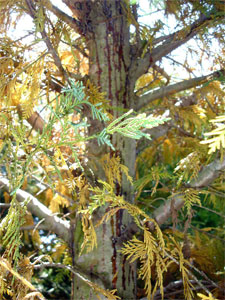
Question: What has happened to my Leyland cypress? They suddenly have developed this seeping sap and dieback. Original e-mail lost by Neil (sorry), but details given are relevant.
Answer: You might want to have Texas A&M’s Plant Disease Diagnostic Laboratory run cultures on the ooze and the wood around it. I’m not familiar with this problem of Leyland cypress. It looks like sunscald, but that normally wouldn’t happen to a plant with evergreen needles shading its trunk. Spider mites and bagworms both bother Leyland cypress trees, too, but this is obviously not being caused by them. I’m not a huge advocate of this plant, as it often runs its course within 15 to 25 years, but this is not a problem I’ve encountered before. We have many professionals who also read e-gardens. Perhaps someone will rescue me. However, it’s not looking good for your tree.

